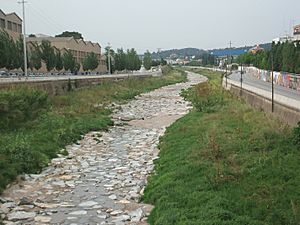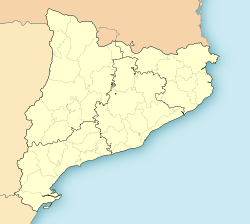Rubí, Barcelona facts for kids
Quick facts for kids
Rubí
|
|||
|---|---|---|---|
|
Municipality
|
|||

Riera de Rubí near the city.
|
|||
|
|||
| Country | |||
| Autonomous community | |||
| Province | Barcelona | ||
| Comarca | Vallès Occidental | ||
| Area | |||
| • Total | 32.3 km2 (12.5 sq mi) | ||
| Elevation | 124 m (407 ft) | ||
| Population
(2018)
|
|||
| • Total | 76,423 | ||
| • Density | 2,366/km2 (6,128/sq mi) | ||
| Demonym(s) | Rubinencs (ca) Rubinense (es) |
||
| Time zone | UTC+1 (CET) | ||
| • Summer (DST) | UTC+2 (CEST) | ||
| Postal code |
08191
|
||
| Official language(s) | Spanish and Catalan | ||
Rubí is a town in Catalonia, Spain. It's located in the Vallès Occidental area, which is part of the province of Barcelona. Rubí is about 15 kilometers away from the big city of Barcelona.
The town is surrounded by other places. To the north, you'll find Terrassa and Ullastrell. To the south is Sant Cugat del Vallès. On the west side is Castellbisbal, and to the east is Sant Quirze del Vallès.
Contents
History of Rubí
Early Beginnings
People think Rubí might have started during the time of the Romans. This is because many old pots called amphoras and ancient writings have been found there. However, the town was officially named Rivo Rubeo in the year 986.
After a leader named Wilfred the Hairy died, the border between Christian lands (Catalan counties) and Muslim lands (Al-Andalus) was set at the Llobregat river. Rubí was very close to this important border.
Building a Castle
In 1233, a person named Berenguer de Rubí asked King Jaume I if he could build a new castle. This castle still stands today and is now a museum about the town, called the Ecomuseu Castell de Rubí.
Growth and Industry
During the Industrial Revolution, many people moved to Rubí. The town's population grew a lot. People started working less in agriculture (farming) and more in textile factories. These factories were built near the Riera de Rubí river. Some of these old factory buildings are still there.
In 1919, Rubí got connected to Barcelona and Terrassa by railway. This made it easier for people and goods to travel. Rich families built beautiful buildings in the Modernisme style, like the Escoles Ribas and Torre Bassas. The Celler Cooperatiu, a special building for farmers working together, was also built around this time.
Modern Industry and Challenges
Over time, many different types of industries came to Rubí. These include textile making, electronics, and chemical products. However, some factories have closed recently and moved to other countries.
Rubí lost most of its farms in 1962. This happened because of very bad flooding. The floods destroyed the lowest parts of the town and affected other cities near the Riera de Rubí. These floods were one of the worst natural disasters in Spain's history.
Since the 1990s, new people have moved to Rubí. They have come from places like South America and North Africa.
Rubí's Economy
The number of people living in Rubí is growing. This is partly because people are moving there from Barcelona. Housing in Barcelona can be very expensive.
Most people in Rubí work in the services sector (about 47.9%). This mainly means working in small shops and businesses. Industry is still very important, with about 40.1% of people working in factories. The number of people looking for jobs (unemployment rate) in Rubí is a bit higher than the average for the whole province.
Main Places to See
Rubí has several interesting places you can visit:
- The Castle: This is the old castle that is now a museum.
- Celler Cooperatiu: A beautiful building built in the Modernist style between 1920 and 1921.
- Church of Sant Pere: A historic church.
- Roman archaeological site of Ca n'Oriol: Where you can see remains from the Roman times.
- Ethnographical Museum: A museum that shows the history and culture of the local people.
- Can Oriol Forest: A nice forest area.
- Typical Farmhouses Route: A path where you can see old, traditional farmhouses.
Education in Rubí
Rubí has many schools for children and teenagers.
Elementary Schools
There are eleven public elementary schools (CEIP) in Rubí:
- CEIP 25 de Setembre
- CEIP Ca n'Alzamora
- CEIP Joan Maragall
- CEIP Maria Montessori
- CEIP Mossèn Cinto Verdaguer
- CEIP Pau Casals
- CEIP Ramon Llull
- CEIP Rivo Rubeo
- CEIP Schola
- CEIP Teresa Altet
- CEIP Torre de la Llebre
Middle Schools
The town has four public middle schools (IES):
- IES Duc de Montblanc
- IES J. V. Foix
- IES L'Estatut
- IES La Serreta
Private Schools
There are also several private schools:
- Regina
- Ribas
- Nostra Senyora de Montserrat
- Balmes
- Escola Maristes de Rubí
Sports in Rubí
Rubí is home to some successful sports teams and athletes.
In-line Hockey
The Cent Patins Rubí is an in-line hockey club. It was started in 1992. This club plays at both national (in Spain) and European levels. Their professional team has won the European Cup Championships in 2009. They also won two national titles in the 2005/06 and 2008/09 seasons.
Football
Rubí's football (soccer) team was founded in 1912. They play in the third division of Spain's football league.
Famous Athletes
MotoE World Cup champion Jordi Torres was born in Rubí.
Transportation in Rubí
Rubí is well-connected by public transport. Its transport lines are part of Barcelona's integrated fare system. This system is managed by the Autoritat del Transport Metropolità.
Railway Lines
Two main railway companies operate in Catalonia and have stations in Rubí.
- Ferrocarrils de la Generalitat de Catalunya (FGC): Their lines, called "Metro del Vallès," connect Barcelona with Terrassa and Sabadell. Lines S1 and S5 stop in Rubí.
- Renfe Rodalies Barcelona: This company opened a new station in Rubí a few years ago. Line R7 serves Rubí's RENFE station. It connects Martorell with Barcelona.
Urban Buses
Rubí has several local bus lines that help people get around town:
- L1 - El Pinar - Can Serrafossà
- L2 - El Pinar/Can Rosés - Can Vallhonrat
- L3 - Castellnou - Estació
- L4 - Can Rosés - Estació
- L5 - Estació - Can Rosés
- L6 - Pol. La Bastida - Pol. Rubí Sud
- L7 - Estació - ?
Interurban Buses
These buses connect Rubí to other towns and cities:
- Autos Castellbisbal. SA: Rubí - El Papiol - Molins de Rei
- Autos Castellbisbal. SA: Rubí - Castellbisbal
- Autos Castellbisbal. SA: Sabadell - Sant Quirze del Vallès - Rubí - Hospital General
- Sarbus nocturno (N61): Barcelona - Rubí - Les Fonts
- Sarbus B7: Rubí - Sant Cugat del Vallès - Cerdanyola del Vallès
- Sarbus B8: Sant Quirze del Vallès - Terrassa - Rubí - Sant Cugat del Vallès
- Transports Generals d'Olesa, S.A.: Ullastrell - Rubí - Terrassa
International Connections
Twin Towns
Rubí has "twin town" or "sister city" relationships with other cities around the world. This means they share cultural and educational links.
See also
 In Spanish: Rubí (Barcelona) para niños
In Spanish: Rubí (Barcelona) para niños




